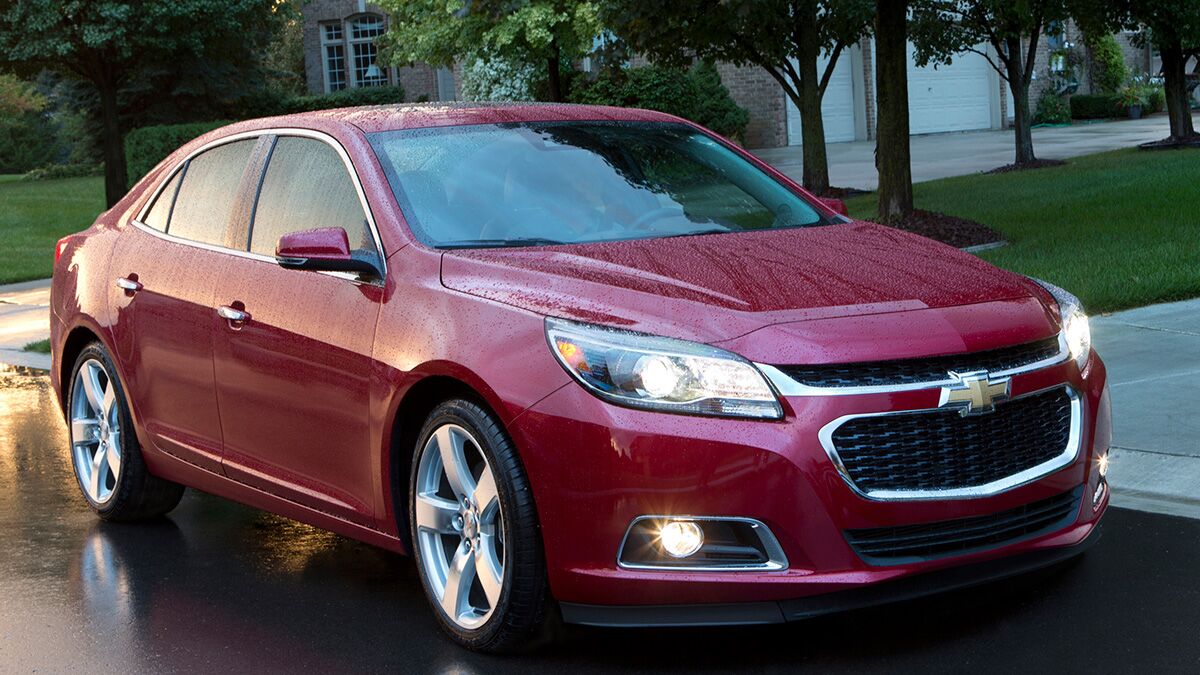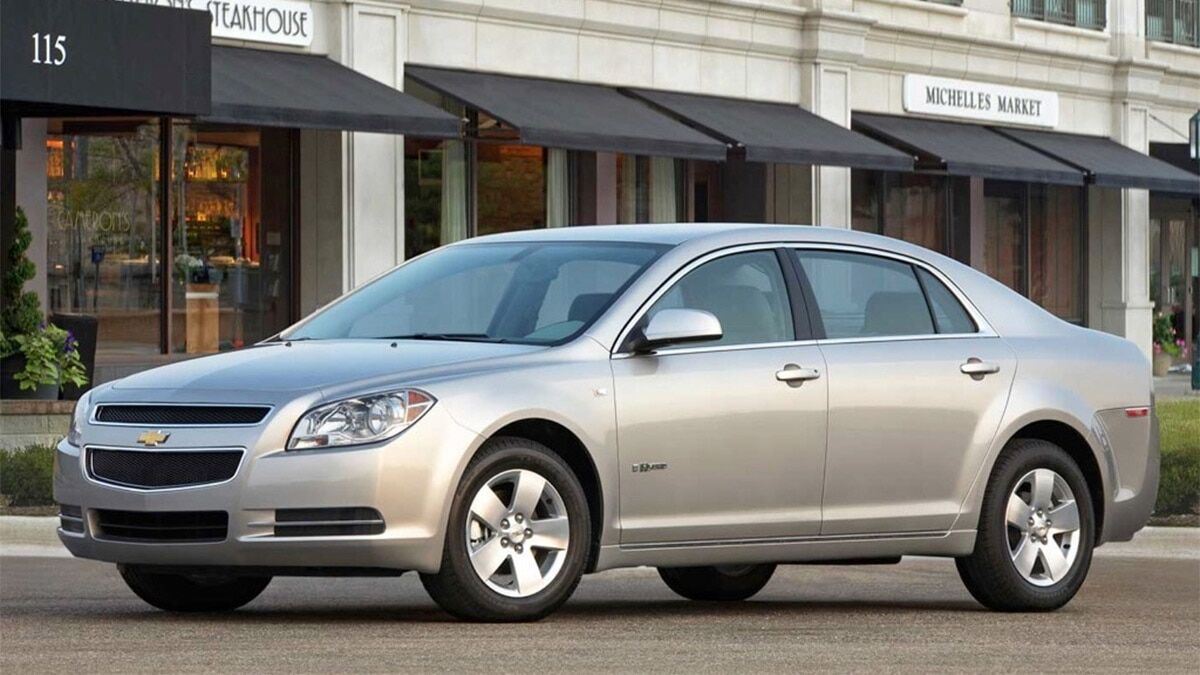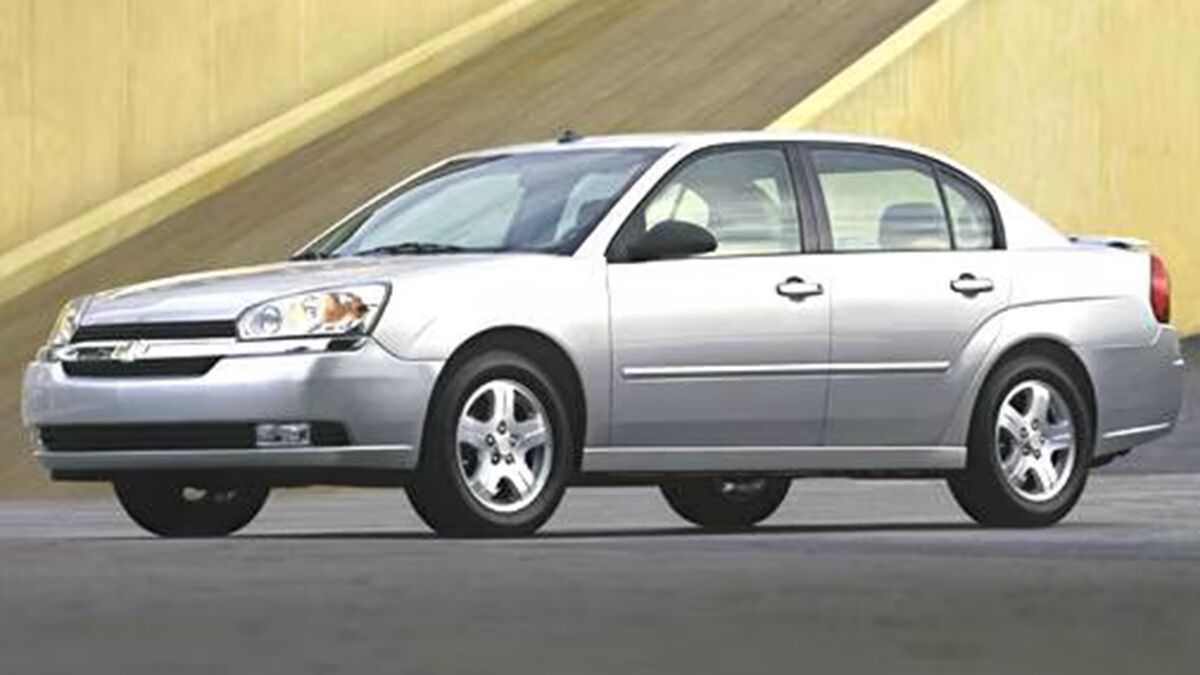Used Chevrolet Malibu Quick Facts
- The best Chevrolet Malibu years to buy used are 2010-2012, 2015, and 2020-2025.
- The Chevrolet Malibu spans over 50 years of production.
- Newer Malibu generations offer a choice of engines, including a powerful V6 and an efficient hybrid.
The Chevrolet Malibu may be one of the most overlooked bargains in the used car market. For most of its life, it’s been a reliable, affordable mode of transport, competing with market leaders like the Honda Accord and Toyota Camry. Over its five-decade run, the Malibu has been everything from a potent muscle car to a miserly 4-cylinder family sedan. In between are a series of generations, some better than others, but all offering the kind of versatile and reliable transportation families desire in a midsize sedan. Later models feature even more desirable features, such as a touchscreen infotainment system, advanced driver-assist features, and a hybrid engine option.
- What Is the Best Model-Year Used Chevrolet Malibu?
- Chevrolet Malibu by Generation: Which Should You Buy?
- Is the Chevrolet Malibu a Good Car?
- How Many Body Styles Does the Chevrolet Malibu Offer?
- Does the Chevrolet Malibu Have a Hybrid Engine?
- Does the Chevrolet Malibu Offer All-Wheel Drive?
- What are the Most Reliable Years for the Chevrolet Malibu?
- What are the Years to Avoid for the Chevrolet Malibu?
What Is the Best Model-Year Used Chevrolet Malibu?
While there are many generations from which to choose, the best used Malibus exist in the last three generations. For the seventh generation, the 2010 through 2012 are the best choice, earning praise from owners and independent rating agencies. The eighth generation has its ups and downs, with early models suffering numerous recalls. 2015 seems to be the best year for this generation. Finally, the nineth and final Malibu generation is probably the best choice. It offers more modern conveniences, better safety tech, and better fuel economy. From this generation, we’d avoid the early 2016-2018 car, but the 2019 through 2025 are all good bets.
See used Chevrolet Malibu sedans near you.
Chevrolet Malibu by Generation: Which Should You Buy?
Ninth Generation: 2016-2025 Chevrolet Malibu

The final Malibu generation is also one of the most technically advanced and makes a good used car choice. Departing from previous generations, the ninth ditches the V6 engine in favor of a series of turbocharged 4-cylinder units.
The standard engine is a 1.5-liter turbocharged 4-cylinder good for 160 horsepower. The LT2 and Premier trims have a 2.0-liter engine pumping out 250 hp, while the hybrid model employs a 1.8-liter engine and dual electric motors for a combined output of 182 hp. The fuel economy of the gas engine is competitive, with a rating of 30 mpg combined for the base 1.5-liter and 26 mpg combined for the 2.0. The hybrid earns 46 mpg combined.
Chevy offers five Malibu trims: L, LS, LT, Hybrid, and Premier.
The L trim isn’t really something you’d want. It’s a fleet vehicle with a bare bones feature set. The LS is a better choice. It features 16-inch alloy wheels, keyless entry and push-button start, cruise control, manual air conditioning, 7-inch MyLink touchscreen infotainment with Apple CarPlay and Android Auto integration, and a rear backup camera.
The LT adds heated side mirrors, 17-inch alloy wheels, SiriusXM satellite radio, and an 8-way power driver’s seat. The Hybrid mirrors the LT and then adds dual-zone automatic climate control.
The Premier features a 2.0-liter engine, 18-inch wheels, navigation, an 8-inch touchscreen, a 9-speaker Bose audio system, dual-zone automatic climate control, a wireless charging pad, heated and ventilated front seats, remote start, perforated leather upholstery, a power passenger seat, and a heated steering wheel.
The Driver Confidence Package, which is optional on the LT, Hybrid, and Premier, includes forward collision warning, automatic emergency braking, a blind-spot monitor, rear cross-traffic detection, automatic high beams, lane keeping assist, and front and rear parking sensors.
The Premier offers the Driver Confidence Package II, which adds adaptive cruise control, forward automatic braking, and semi-automatic parking assist.
Additional options for the LT include leather upholstery, a power sunroof, the Bose audio upgrade, a wireless charging pad, dual-zone automatic climate control, power front seats, and a sport package.
Be aware that Chevrolet carried over the eighth-generation Malibu for 2016, labeling it the Malibu Classic. If you’re looking at a 2016 Malibu Classic, it’s not the same car as the 2016 Malibu.
Model Year Changes:
2025: Final year for the Malibu.
2024: Rear park assist and a tire inflator kit made standard.
2023: The Driver Confidence package becomes standard, while the Premier trim and its 250-hp 2.0-liter motor disappear from the lineup.
2022: Chevy drops the L trim.
2021: Wireless Apple CarPlay/Android Auto made standard.
2020: Chevy drops the hybrid engine, the Premier gains 19-inch wheels and a power sunroof, and a new Redline Edition arrives.
2019: Models equipped with the 1.5-liter engine get a new CVT automatic. The RS trim debuts, and all models get a new 8-inch driver information display.
2018: L, LS, and LT trims get a slightly larger fuel tank.
2017: The 2.0-liter engine gets a new 9-speed automatic, and Apple CarPlay/Android Auto integration is available on the LS and LT trims.
See 2016-2025 Chevrolet Maibu sedans near you.
Eighth Generation: 2013-2015 Chevrolet Malibu

The eighth-generation Malibu had a short run, produced for only three years. However, as used cars go, there is one year in this generation that makes it a great used car choice. While the 2013 and 2014 models have their share of issues and recalls, Chevy seems to have straightened them all out in the final year, making the 2015 one of the most reliable used sedans for that year.
There are four trims for the Malibu: LS, Eco, LT, and LTZ. Standard in all but the Eco is a 2.5-liter 4-cylinder good for 197 hp. The Eco uses a slightly smaller 2.4-liter engine developing 182 hp and offering a few mpg better mileage. Optional on the LTZ is a 259-hp 2.0-liter turbocharged engine.
The LS includes an AM/FM/CD radio, cruise control, air conditioning, remote keyless entry, and Bluetooth. The LT adds a 7-inch touchscreen, a power driver’s seat, and Bluetooth streaming. The LTZ adds a power passenger seat, heated front seats, and leather upholstery.
Optional upgrades for the LT and LTZ include driver assist like forward collision warning, a blind-spot monitor, and rear cross-traffic alert. Other options include a power sunroof, navigation, HID headlights, keyless access with push-button start, and a 9-speaker Pioneer audio system.
The 2013 Malibu has the most problems of the group. It is plagued by electrical issues arising from a defective fuse box part that caused the touchscreen to flicker and the power steering module to stop working. There are issues with wheel bearings, poor soldering on an essential circuit board, and a defective accelerator pedal position sensor that can cause the engine to go into limp mode.
The 2.0-liter engine is prone to rough idle due to defective camshaft position actuator solenoid valves, while the 2.5-liter has premature water pump failure issues.
To see a complete list of recalls and complaints regarding the 2013-2015 Chevrolet Malibu, visit the National Highway Traffic Safety Administration website.
Model Year Changes:
2015: Chevy adds 4G LTE Wi-Fi
2014: The Malibu gains engine start-stop on the 2.5-liter engine and sees slight revisions to the suspension and interior.
See 2013-2015 Chevrolet Malibu sedans near you.
Seventh Generation: 2008-2012 Chevrolet Malibu

The seventh-generation Malibu has some good and not-so-good years, but overall, it rates as a good used car. You won’t find advanced driver aids like adaptive cruise control or forward emergency braking here, but you will find a V6 engine, a roomy cabin, and European-inspired ride and handling.
The Malibu offers a choice of a 169-hp 2.4-liter 4-cylinder or 252-hp 3.5-liter V6. There’s also a mild hybrid engine option pairing a small electric motor with the 2.4-liter engine for about a two-mile-per-gallon improvement.
This model’s wheelbase is six inches longer than that of the sixth-generation Malibu, creating more front seat legroom but sacrificing rear seat space and trunk volume.
Initial reception for this generation was good, and it won all manner of awards and accolades, including the North American Car of the Year. But shortly thereafter, problems began to arise with the 4-speed automatic transmission on some cars. Early models also have issues with the 6-speed automatic, electric power steering, body control module, and premature suspension component wear.
The 2.4 and 3.5-liter engines also suffer from stretched timing chains and, on the 2.4, excessive oil consumption. The problem lay in the initial oil change intervals, which the Malibu’s onboard monitor put at 10,000 to 12,000 miles. This allowed the oil to break down and put stress on the timing chain, causing it to stretch. It is now recommended that you change your oil every 3,000 to 5,000 miles.
The 2011 and 2012 models address many of these issues, although the timing chain issue remains.
Given the age and mileage of this generation as a used car purchase, it’s a good idea to have a qualified mechanic provide a thorough inspection before purchase.
Model Year Changes:
2012: Chevy offers some new packages for the LT trim.
2011: All trims get the 6-speed automatic transmission.
2010: 1LT trims get a 6-speed automatic, while all trims gain driver’s seat power lumbar.
2009: Chevy makes its StabiliTrak traction control standard.
The Chevrolet Malibu Early Years: Generations One Through Six (1964-2004)

2004-2007
The sixth-gen Malibu rides on a European Opel platform powered by various engines. The base model has a 2.2-liter 4-cylinder, but the LS and LT offer a more powerful 3.5-liter V6. The sporty SS trim has a 3.9-liter V6 good for 240 hp. Alongside the Malibu sedan is the Malibu Maxx, a five-door wagon with a fixed glass panel roof and a rear seat that can slide fore and aft. Regrettably, this generation doesn’t have a very good track record for reliability, especially the 2004, 2005, and 2007 models.
1997-2005
The fifth-generation Malibu marks the return of the Malibu name after a 14-year absence. It’s a conservatively styled sedan powered by one of two engines: a 150-hp 2.4-liter 4-cylinder or 155-hp 3.1-liter V6. Reliability ratings are average for these years, and they are nowhere near what the Toyota Camry or Honda Accord post, but then again, a used Malibu won’t cost as much.
1978-1983
The Malibu joined the rest of its GM stablemates in undergoing a massive downsizing effort. Offered as a coupe, wagon, or sedan, the intermediate Malibu weighed less and offered better fuel economy than its predecessor. Oddities like the sedan and wagon’s fixed rear windows that don’t roll down didn’t seem to dent sales, and increased the take rate on the optional (and profitable) air conditioner. Fancy two-tone paint, colorful interiors, and upscale options gave the Malibu the feeling of being a mini Caprice Classic.
1973-1977
The Malibu went from being a sporty muscle car to a humble family hauler, retaining its coupe, sedan, and wagon body styles but with far weaker engines. The entry-level power plant was a 250-cubic-inch inline 6-cylinder, followed by a number of V8 engines, including the 305, 350, 400, and 454. Depending on how much buyers were willing to spend, the Malibu could be anything from a bare-bones transport to a sporty coupe or luxurious sedan/wagon.
1968-1972
The muscle car Malibu shared its platform with the Chevelle, although it remained a complete lineup, including a sedan and wagon. This generation is the last time the Malibu name adorned a convertible and hardtop coupe. Highly sought after by collectors, especially the big block engine cars, find one of these in good condition and you’ll have a future collectible.
1964-1967
Chevrolet introduced the Malibu as an upscale subseries of its popular Chevelle. The dynamic model range included a sedan, wagon, 2-door hardtop, and convertible. The Malibu SS is the most desirable car from this generation, offering a series of powerful V8 powerplants, including a 350-hp 327 and a 375-hp 396.
Is the Chevrolet Malibu a Good Car?
Late models from the seventh, eighth, and nineth generations make good used car prospects. If you don’t need fancy infotainment or advanced driver assists, an older model will save you a ton of cash.
How Many Body Styles Does the Chevrolet Malibu Offer?
Depending on the year, the Malibu body styles include a sedan, five-door hatchback, a coupe, and a wagon.
Does the Chevrolet Malibu Have a Hybrid Engine?
Chevrolet first offered a mild hybrid engine in the 2009 model and later, the e-Assist version in the 2013 Malibu. A full hybrid version doesn’t arrive until 2019.
Does the Chevrolet Malibu Offer All-Wheel Drive?
All Malibus before 1983 had rear-wheel drive. After 1997, the Malibu switched to a front-drive platform, and all-wheel drive was never an option.
What are the Most Reliable Years for the Chevrolet Malibu?
Depending on the generation, we’d go for the 2010-2012 Malibu from the seventh generation, 2015 from the eighth, and 2020-2025 for the ninth.
What Are the Years To Avoid for the Chevrolet Malibu?
The most problematic years for the Malibu are 2000 through 2005, 2008, 2013, and some 2016-2017 models.











